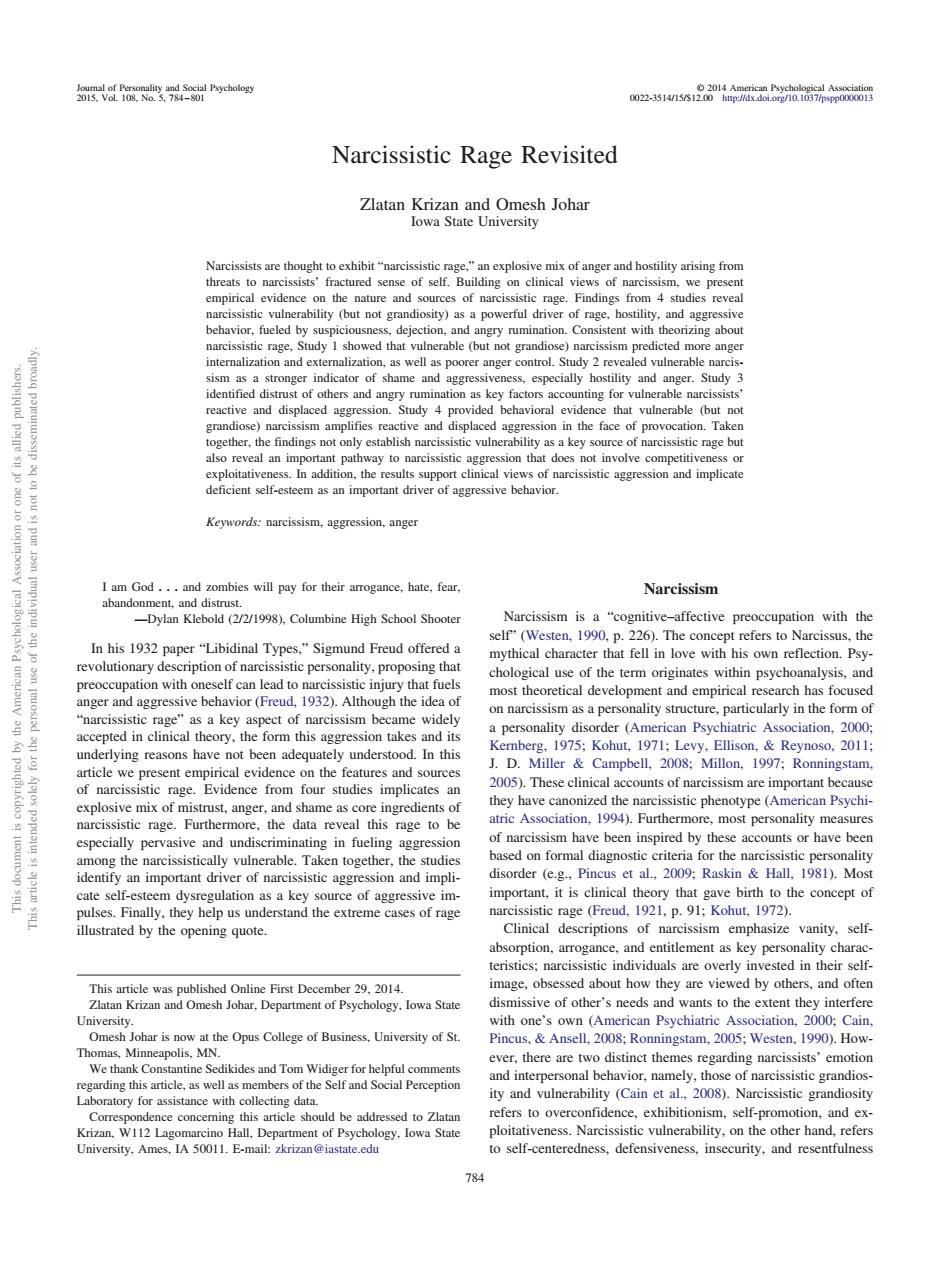正在加载图片...

深yae mm.31w1s1品21 Narcissistic Rage Revisited ZamK0a时o 4o tent wit ing abou Narcissism pation with the n wit (Freud.1932). explosive mix of mistrust,anger,and shame as core ients e rage his rag of narcissism have been inspired by these accounts or have been vulne able.Taken ogether,the studies of na sistic agg 1.p.9 1972). trated by the opening quote absomtion arrogance and entitlement as key ner ality char ested in their self W292014 logy,lowa State f other's tent vith one's own (Am ation.2000:Cair nal behavior.namely.th se o and vulnerability (Cain et al grand University.Ames.IA 50011.E-mailiastae.edu to self-centeredness,defensiveness.insecurity.and resentfulness 78Narcissistic Rage Revisited Zlatan Krizan and Omesh Johar Iowa State University Narcissists are thought to exhibit “narcissistic rage,” an explosive mix of anger and hostility arising from threats to narcissists’ fractured sense of self. Building on clinical views of narcissism, we present empirical evidence on the nature and sources of narcissistic rage. Findings from 4 studies reveal narcissistic vulnerability (but not grandiosity) as a powerful driver of rage, hostility, and aggressive behavior, fueled by suspiciousness, dejection, and angry rumination. Consistent with theorizing about narcissistic rage, Study 1 showed that vulnerable (but not grandiose) narcissism predicted more anger internalization and externalization, as well as poorer anger control. Study 2 revealed vulnerable narcissism as a stronger indicator of shame and aggressiveness, especially hostility and anger. Study 3 identified distrust of others and angry rumination as key factors accounting for vulnerable narcissists’ reactive and displaced aggression. Study 4 provided behavioral evidence that vulnerable (but not grandiose) narcissism amplifies reactive and displaced aggression in the face of provocation. Taken together, the findings not only establish narcissistic vulnerability as a key source of narcissistic rage but also reveal an important pathway to narcissistic aggression that does not involve competitiveness or exploitativeness. In addition, the results support clinical views of narcissistic aggression and implicate deficient self-esteem as an important driver of aggressive behavior. Keywords: narcissism, aggression, anger I am God ... and zombies will pay for their arrogance, hate, fear, abandonment, and distrust. —Dylan Klebold (2/2/1998), Columbine High School Shooter In his 1932 paper “Libidinal Types,” Sigmund Freud offered a revolutionary description of narcissistic personality, proposing that preoccupation with oneself can lead to narcissistic injury that fuels anger and aggressive behavior (Freud, 1932). Although the idea of “narcissistic rage” as a key aspect of narcissism became widely accepted in clinical theory, the form this aggression takes and its underlying reasons have not been adequately understood. In this article we present empirical evidence on the features and sources of narcissistic rage. Evidence from four studies implicates an explosive mix of mistrust, anger, and shame as core ingredients of narcissistic rage. Furthermore, the data reveal this rage to be especially pervasive and undiscriminating in fueling aggression among the narcissistically vulnerable. Taken together, the studies identify an important driver of narcissistic aggression and implicate self-esteem dysregulation as a key source of aggressive impulses. Finally, they help us understand the extreme cases of rage illustrated by the opening quote. Narcissism Narcissism is a “cognitive–affective preoccupation with the self” (Westen, 1990, p. 226). The concept refers to Narcissus, the mythical character that fell in love with his own reflection. Psychological use of the term originates within psychoanalysis, and most theoretical development and empirical research has focused on narcissism as a personality structure, particularly in the form of a personality disorder (American Psychiatric Association, 2000; Kernberg, 1975; Kohut, 1971; Levy, Ellison, & Reynoso, 2011; J. D. Miller & Campbell, 2008; Millon, 1997; Ronningstam, 2005). These clinical accounts of narcissism are important because they have canonized the narcissistic phenotype (American Psychiatric Association, 1994). Furthermore, most personality measures of narcissism have been inspired by these accounts or have been based on formal diagnostic criteria for the narcissistic personality disorder (e.g., Pincus et al., 2009; Raskin & Hall, 1981). Most important, it is clinical theory that gave birth to the concept of narcissistic rage (Freud, 1921, p. 91; Kohut, 1972). Clinical descriptions of narcissism emphasize vanity, selfabsorption, arrogance, and entitlement as key personality characteristics; narcissistic individuals are overly invested in their selfimage, obsessed about how they are viewed by others, and often dismissive of other’s needs and wants to the extent they interfere with one’s own (American Psychiatric Association, 2000; Cain, Pincus, & Ansell, 2008; Ronningstam, 2005; Westen, 1990). However, there are two distinct themes regarding narcissists’ emotion and interpersonal behavior, namely, those of narcissistic grandiosity and vulnerability (Cain et al., 2008). Narcissistic grandiosity refers to overconfidence, exhibitionism, self-promotion, and exploitativeness. Narcissistic vulnerability, on the other hand, refers to self-centeredness, defensiveness, insecurity, and resentfulness This article was published Online First December 29, 2014. Zlatan Krizan and Omesh Johar, Department of Psychology, Iowa State University. Omesh Johar is now at the Opus College of Business, University of St. Thomas, Minneapolis, MN. We thank Constantine Sedikides and Tom Widiger for helpful comments regarding this article, as well as members of the Self and Social Perception Laboratory for assistance with collecting data. Correspondence concerning this article should be addressed to Zlatan Krizan, W112 Lagomarcino Hall, Department of Psychology, Iowa State University, Ames, IA 50011. E-mail: zkrizan@iastate.edu This document is copyrighted by the American Psychological Association or one of its allied publishers. This article is intended solely for the personal use of the individual user and is not to be disseminated broadly. Journal of Personality and Social Psychology © 2014 American Psychological Association 2015, Vol. 108, No. 5, 784 – 801 0022-3514/15/$12.00 http://dx.doi.org/10.1037/pspp0000013 784